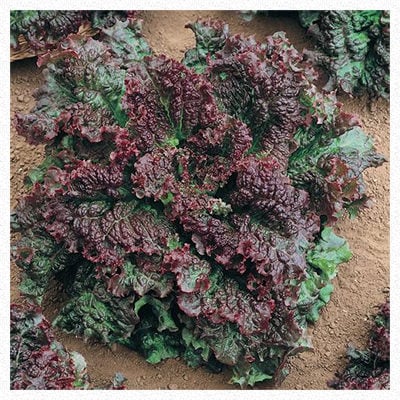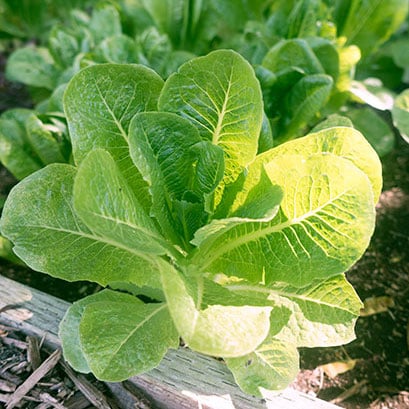
Learning Download: How to Grow Lettuce
From Seed to Harvest: A guide to growing lettuce.
Homegrown lettuce offers more vitamins and variety than that bought at the store, and it can add color to tossed salads and other dishes. Lettuce is an excellent source of vitamin A.
To plant:
Lettuce is a cool-season crop, and seedlings can tolerate a light frost. Lettuce grows quickly, so stagger the plantings.It is recommended to sow the lettuce seeds directly into the garden as soon as the soil can be worked. Plant seeds 1/2 inch deep in single rows. If you want an earlier crop, lettuce can be started indoors four to six weeks before the last frost.
To grow:
Once seedlings begin to appear, thin them. For leaf lettuce, thin to 4 inches apart. For loose-headed lettuces, thin to 8 inches apart. For firm-headed types, thin to 16 inches apart. To prevent aphids, plant chives or garlic between your rows of lettuce. Water lettuce when its leaves are wilting slightly and weed by hand. Lettuce has shallow roots, so weed carefully. Plant lettuce near taller plants, like tomatoes, so the leaves are in the shade during the hot parts of the day. Mulch lettuce with compost or straw to retain moisture.
To harvest:
Lettuce can be picked whenever real leaves form. Pick when the leaves are younger rather than waiting so the taste doesn’t become bitter. For heads of lettuce, cut the plant at the soil line to harvest it. For leaf lettuces, you can harvest the entire plant or only the outer leaves as needed. Harvest in the morning.
What lettuce craves:
Lettuce is typically a care-free plant, but you can fertilize the soil with an organic fertilizer one week prior to planting the seeds. Lettuce grows best in soil that is high in humus. Fertilize three weeks after transplanting seedlings with an alfalfa meal or a slow-release fertilizer.
Where to buy lettuce seeds:
You can find a wide variety of lettuce seeds of all different colors and flavors at Urban Farmer.
Learning Download: Common pests and diseases: Lettuce
Common pests and diseases: Lettuce
When growing vegetables, it is always exciting to care for the plant throughout its growing phase and then harvest it for delicious recipes later on, but one thing to watch out for is pests and diseases. Different plants are susceptible to different types of pests and diseases, and it is important to make yourself aware so you can keep a watchful eye and also take any preventative methods to keep your plants safe throughout their lifespan.
Lettuce can fall victim to several different pests and diseases.
Pests:
The most common pest affecting all different types of greens, including lettuce, is the aphid or the leafhopper. Aphids and leafhoppers both can easily spread diseases amongst lettuce plants.
Aphids are small, soft-bodied insects and they come in colors green, yellow or purple. Leafhoppers will be green-yellow and small. If you notice either of these pests on your lettuce, spray them with an insecticidal soap every 10 days to discourage them. To help prevent an infestation, continuously weed your greens because unwelcome weeds may serve as the home to leafhoppers.
Cutworms are another pest that can affect lettuce. They will eat the leaves and the stems of the plant. To rid of these pests, pick them off by hand.
A tarnished plant bug will eat the head of the lettuce, and it is oval and has black, yellow and brown markings. Alfalfa plants attract the bug, so try not to plant lettuce near alfalfa. Use organic pesticides once you notice an infestation.
The Western-spotted cucumber beetle is another insect that can cause harm to your lettuce plants. They are yellow with black spots and can also bring several diseases such as bacterial wilt and cucumber mosaic virus to the lettuce.
Diseases:
Some of the common diseases affecting lettuce include anthracnose, bottom rot, damping off and more.
Anthracnose is a fungus which survives in the debris of infected plants, but it also can survive in the soil. Destroy infected plants as soon as possible, but don’t compost them. The fungus is attracted to moist conditions so try to keep the lettuce dry.
Bottom rot is also a fungus affecting lettuce. It mostly attacks adult lettuce in soil that doesn’t drain well. This fungus will cause necrosis on the stems or leaves. It also causes the lettuce to wilt. To prevent this, avoid overhead watering.
Damping off is a fungus that lives in the soil and is most likely to affect young lettuce plants or seedlings. It will cause water filled spots and wilting. This disease is more common in wet or damp conditions. To prevent it from happening, plant your lettuce in well-draining soil, or properly water your plants and don’t utilize overhead watering.
Learning Download: Lettuce Comparison Chart
Lettuce Comparison Chart
| Type | Variety | Days to Maturity | Color | Use |
| Batavia | Chrystal Batavian | 30-50 | Purple-red with green hearts | Full size |
| Butterhead/Bibb | All the Year Round** | 60-73 | Dark green | Full size |
| Butterhead/Bibb | Bibb** | 57 | Green | Mini head |
| Butterhead/Bibb | Butter King** | 60 | Green | Full size |
| Butterhead/Bibb | Buttercrunch** | 65 | Light green | Full size |
| Butterhead/Bibb | Carmona Red** | 55 | Red with green hearts | Full size |
| Butterhead/Bibb | Continuity** | 70 | Dark green with bronze-red tips | Full size |
| Butterhead/Bibb | Marvel of Four Seasons** | 60 | Bronze red with green hearts | Full size |
| Butterhead/Bibb | Sante Fe** | 55 | Green with bronze-red tips | Full size |
| Butterhead/Bibb | Tom Thumb** | 50-70 | Green | Full size |
| Butterhead/Bibb | White Boston** | 60-72 | Light green | Full size |
| Iceberg | Calmar | 75 | Dark green | Full size |
| Iceberg | Great Lakes 118*** | 75 | Dark green | Full size |
| Iceberg | Iceberg | 85 | Green | Full size |
| Looseleaf | Black Seeded Simpson** | 45 | Light green | Baby leaf |
| Looseleaf | Bronze Mignonette** | 65 | Green and bronze | Full size |
| Looseleaf | Deer Tongue | 28-50 | Medium green | Baby leaf |
| Looseleaf | Freckles | 55 | Green with red “freckles” | Full size |
| Looseleaf | Gabriella | 25-50 | Green and dark red | Baby leaf or full size |
| Looseleaf | Grand Rapids TBR | 45 | Green | Full size |
| Looseleaf | Green Ice** | 45 | Green | Full size |
| Looseleaf | Merlot** | 35-50 | Dark red | Baby leaf or full size |
| Looseleaf | Midnight Ruffles | 45 | Dark red | Baby leaf or full size |
| Looseleaf | Prizehead** | 45 | Green with red tips | Full size |
| Looseleaf | Ruby Red*** | 40-53 | “Ruby” red with green hearts | Full size |
| Looseleaf | Sunset*** | 50 | Deep red | Baby leaf |
| Looseleaf | Seafresh** | 45 | Blue green | Full size |
| Looseleaf | Waldmans Green** | 28-45 | Light green | Baby leaf |
| Lollo | Lollo Rosa Darky | 72 | Dark red with light green heart | Baby leaf |
| Lollo | Selway** | 30-55 | Dark purple with light green heart | Full size |
| Oakleaf | Green Salad Bowl** | 50 | Green | Baby leaf |
| Oakleaf | Oakleaf | 65 | Light green | Baby leaf |
| Oakleaf | Red Salad Bowl** | 50 | Red | Baby leaf |
| Oakleaf | Royal Oakleaf | 50 | Blue green | Baby leaf |
| Oakleaf | Tango** | 28-50 | Green | Baby leaf |
| Romaine/Cos | Cimarron | 28-65 | Green-red with dark red tips | Baby leaf |
| Romaine/Cos | Dwarf Romaine | 28-70 | Green | Baby leaf |
| Romaine/Cos | Green Towers | 60 | Dark green | Full size |
| Romaine/Cos | Jericho** | 28-58 | Green | Baby leaf |
| Romaine/Cos | Little Gem | 30-50 | Dark green | Baby leaf or full size |
| Romaine/Cos | Parris Island Cos** | 22-55 | Green | Baby leaf |
| Romaine/Cos | Red Romaine** | 40 | Green and redish-purple | Full size |
| Romaine/Cos | Rouge D’Hiver** | 60-65 | Green and col-md-red | Baby leaf |
| Romaine/Cos | Vivian** | 35-50 | Dark green | Baby leaf |
| Romaine/Cos | Winter Density** | 54 | Green | Full size |
*All American Selection Winner
**Heirloom
***AAS Winner/Heirloom


